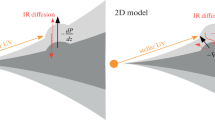Abstract
Heating by the central star is one of the key factors determining the physical structure of protoplanetary disks. Due to a large radial optical thickness, the equatorial regions of the disk are heated by infrared radiation from the disk surface (atmosphere), which in turn is heated by the direct radiation from the star. It was previously shown that interception of the stellar radiation by inhomogeneities on the disk surface can cause perturbations that propagate towards the star. In this work, within a detailed 1+1D-dimensional numerical model of a protoplanetary disk, the occurrence of such waves is studied. It was found that, in a disk that is optically thick to its own radiation, surface perturbations indeed form and propagate towards the star, which confirms the conclusions of other authors. However, in contrast to analytical predictions, we found that, for sufficiently massive disks, thermal waves affect only the upper layers without significant temperature fluctuations in the equatorial plane. The results obtained indicate the need to study this instability within more consistent hydrodynamic models.






Similar content being viewed by others
REFERENCES
C. L. Brogan, L. M. Pérez, T. R. Hunter, W. R. F. Dent, et al., Astrophys. J. Lett. 808, L3 (2015); ar**v: 1503.02649 [astro-ph.SR].
S. M. Andrews, Ann. Rev. Astron. Astrophys. 58, 483 (2020); ar**v: 2001.05007 [astro-ph.EP].
J. Huang, S. M. Andrews, C. P. Dullemond, A. Isella, et al., Astrophys. J. Lett. 869, L42 (2018); ar**v: 1812.04041 [astro-ph.EP].
C. Baruteau, A. Crida, S. J. Paardekooper, F. Masset, et al., in Protostars and Planets VI, Ed. by H. Beuther, R. S. Klessen, C. P. Dullemond, and T. Henning (Univ. of Arizona Press, Tucson, 2014), p. 667; ar**v: 1312.4293 [astro-ph.EP].
R. Dong, Z. Zhu, and B. Whitney, Astrophys. J. 809, 93 (2015); ar**v: 1411.6063 [astro-ph.EP].
G. Dipierro, G. Laibe, D. J. Price, and G. Lodato, Mon. Not. R. Astron. Soc. 459, L1 (2016); ar**v: 1602.07457 [astro-ph.EP].
J. Bae, Z. Zhu, and L. Hartmann, Astrophys. J. 850, 201 (2017); ar**v: 1706.03066 [astro-ph.EP].
S. Zhang, Z. Zhu, J. Huang, V. V. Guzmán, et al., Astrophys. J. Lett. 869, L47 (2018); ar**v:1812.04045 [astro-ph.EP].
P. D’Alessio, J. Cantó, L. Hartmann, N. Calvet, and S. Lizano, Astrophys. J. 511, 896 (1999).
C. P. Dullemond, Astron. Astrophys. 361, L17 (2000); ar**v: astro-ph/0007399.
S.-I. Watanabe and D. N. C. Lin, Astrophys. J. 672, 1183 (2008); ar**v: 0709.1760 [astro-ph].
R. Siebenmorgen and F. Heymann, Astron. Astrophys. 539, A20 (2012); ar**v: 1201.3577 [astro-ph.SR].
T. Ueda, M. Flock, and T. Birnstiel, Astrophys. J. Lett. 914, L38 (2021); ar**v: 2105.13852 [astro-ph.EP].
Y. Wu and Y. Lithwick, ar**v: 2105.02680 [astro-ph.EP] (2021).
E. I. Vorobyov and Y. N. Pavlyuchenkov, Astron. Astrophys. 606, A5 (2017); ar**v: 1706.00401 [astro-ph.GA].
Y. N. Pavlyuchenkov, A. V. Tutukov, L. A. Maksimova, and E. I. Vorobyov, Astron. Rep. 64, 1 (2020); ar**v: 1912.08572 [astro-ph.SR].
L. A. Maksimova, Y. N. Pavlyuchenkov, and A. V. Tutukov, Astron. Rep. 64, 815 (2020); ar**v: 2009.07750 [astro-ph.SR].
N. N. Kalitkin, Numerical Methods (Nauka, Moscow, 1978) [in Russian].
A. N. Youdin and J. Goodman, Astrophys. J. 620, 459 (2005); ar**v: astro-ph/0409263.
ACKNOWLEDGMENTS
We are grateful to the reviewer for valuable comments and suggestions for improving the article.
Funding
This work was supported by the Russian Foundation for Basic Research, project no. 20-32-90103. VVA was supported by the Foundation for the Advancement of Theoretical Physics and Mathematics “BASIS” (20-1-2-20-1).
Author information
Authors and Affiliations
Corresponding author
Ethics declarations
The authors declare that they have no conflicts of interest.
Additional information
Translated by E. Chernokozhin
Rights and permissions
About this article
Cite this article
Pavlyuchenkov, Y.N., Maksimova, L.A. & Akimkin, V.V. Simulation of Thermal Surface Waves in a Protoplanetary Disk in 1+1D Approximation. Astron. Rep. 66, 321–329 (2022). https://doi.org/10.1134/S1063772922050055
Received:
Revised:
Accepted:
Published:
Issue Date:
DOI: https://doi.org/10.1134/S1063772922050055




